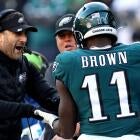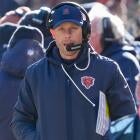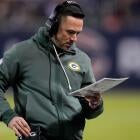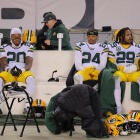AFC North positional and coaching rankings: Mike Tomlin tops John Harbaugh; Joe Burrow edges Lamar Jackson
A position-by-position breakdown of the NFL's most competitive division
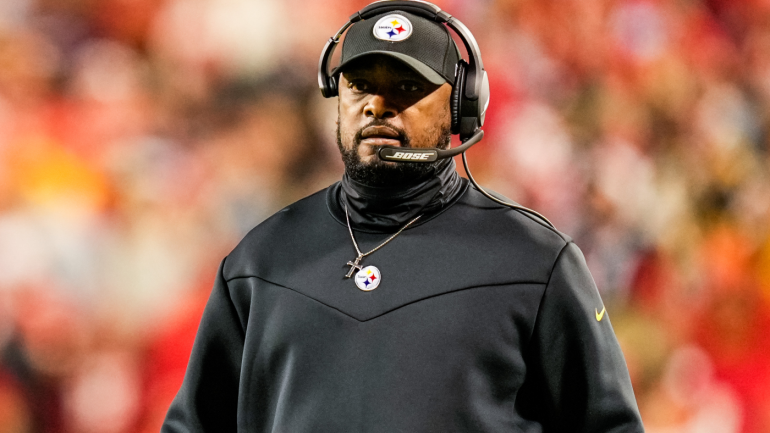
There are seven divisions in the NFL, and then there's the AFC North division. OK, that may be a little dramatic, but there's no denying that the AFC North is arguably the NFL's toughest and most competitive division, and that at least somewhat distinguishes it from the rest of the pack.
Fresh off making history as the first division to see each team record a winning record, the AFC North isn't expected to cool off this year. In fact, with quarterbacks Joe Burrow and Deshaun Watson back from last year's season-ending injuries, the Steelers' revamped quarterback room and the Ravens' offseason signing of former 2,000-yard rusher Derrick Henry, the AFC North should be even better this season.
It should be no surprise that the AFC North has several close calls when it comes to positional rankings. Let's go through each one while also ranking the four head coaches who make up the North.
Quarterbacks
1. Bengals (Joe Burrow)
2. Ravens (Lamar Jackson)
3. Steelers (Russell Wilson)
4. Browns (Deshaun Watson)
This was a fun list to make, albeit somewhat of a challenge. Burrow was chosen over Jackson largely because of how well Burrow has played whenever he is healthy. He led the Bengals to the Super Bowl and an AFC Championship game appearance in his only two full seasons of action up to this point. Jackson, a great player in his own right with two MVP trophies to his credit, has struggled to live up to high expectations in the playoffs.
I'm sure there's more than a few people who are surprised to see Watson ranked below Wilson, but last year's statistical evaluations of both players made that decision rather easy. Wilson bested Watson in just about every category prior to Watson suffering a season-ending injury after six starts. Watson has yet to return to his Pro Bowl form in Cleveland, while Wilson -- despite getting benched late in the 2023 season -- had what could be considered a bounce-back season after a extremely rough 2022 campaign.
Running back
1. Steelers (Najee Harris, Jaylen Warren)
2. Browns (Nick Chubb, Jerome Ford)
2. Ravens (Derrick Henry)
4. Bengals (Chase Brown, Zack Moss)
Similar to quarterback, this was a fun list to make, and surprisingly not too difficult. Harris and Warren have quickly become arguably the league's top running back duo after combining to amass 2,359 all-purpose yards and 12 touchdowns in 2023. It helps that they will now play in new offensive coordinator Arthur Smith's run-first offense.
Despite Henry turning 30, I still believe that the two-time rushing champion still has a few highly productive seasons left in him. But that was not enough to put him ahead of Chubb and Ford despite Chubb still recovering from last year's major knee injury. If Chubb is healthy, he and Ford are as good as a duo as any in the NFL.
Wide receiver
1. Bengals (Ja'Marr Chase, Tee Higgins)
2. Browns (Amari Cooper, Elijah Moore, Jerry Jeudy)
3. Ravens (Zay Flowers, Rashod Bateman, Nelson Agholor)
4. Steelers (George Pickens, Van Jefferson)
Pickens is a rising star, and Jefferson has enjoyed a solid start to his time in the black and gold, especially as a possible deep threat. But Pittsburgh's unproven depth at wideout was the main reason why it takes up the rear. That could change, however, if Calvin Austin III and rookie Roman Wilson play up to coach Mike Tomlin's expectations.
There's no denying, however, the Bengals' rightful place atop this particular list. Chase and Higgins are arguably the best receiver duo in the NFL, a partnership that may be ending its final season together with Higgins set to possibly enter free agency next offseason.
Tight end
1. Ravens (Mark Andrews)
2. Browns (David Njoku)
3. Steelers (Pat Freiermuth)
4. Bengals (Mike Gesicki)
Despite last year's season-ending injury, Andrews was given the top spot over Njoku, who is coming off his first Pro Bowl campaign. Freiermuth's production this season should be closer to what he did as a rookie, when he caught a career-high seven touchdown passes (he's had just four touchdown catches since then). Gesicki is the latest in a never-ending cycle of veteran tight ends that come through Cincinnati on an annual basis. We'll see if he can manage to stick around beyond this season.
Offensive line
1. Browns
2. Bengals
3. Steelers
4. Ravens
For now, the Bengals' more seasoned unit is ahead of a Steelers offensive line that has potential. Pittsburgh has three promising rookies in center Zach Frazier, tackle Troy Fautanu and guard Mason McCormick. The line also includes 2023 first-round pick Broderick Jones (who is surely looking to bounce back following a tough preseason) and reliable veterans Isaac Seumalo and James Daniels.
Cincinnati has a solid core that includes center Ted Karras and fellow veterans (and former free agent additions) Alex Cappa, Cordell Volson and Orlando Brown Jr. The Bengals added some new faces at tackle this offseason with the first-round pick of Amarius Mims and the free agent signing of Trent Brown. Overall, though, Cincinnati's depth on the offensive line isn't great. The unit also needs Orlando Brown (a former Pro Bowler in Baltimore and Kansas City) to elevate his game.
Defensive line
1. Ravens (Justin Madubuike, Michael Pierce, Broderick Washington)
2. Steelers (Cam Heyward, Larry Ogunjobi, Keeanu Benton)
3. Browns (Dalvin Tomlinson, Shelby Harris)
4. Bengals (B.J. Hill, Sheldon Rankins)
Baltimore having one of the NFL's premier defensive lineman (Madubuike) made this a somewhat easy choice. Madubuike's 13 sacks last year was 2.5 more sacks more than the next-closest defensive tackle, which was Chiefs All-Pro Chris Jones.
The Steelers are expecting for a breakout year from Benton and a bounce-back season from Heyward, who was injured for basically all of 2023. In Rankins, the Bengals acquired a solid pass rusher but an inferior run-stuffer to replace D.J. Reader, who signed with the Lions after not being retained by Cincinnati.
Edge rushers
1. Steelers (T.J. Watt, Alex Highsmith)
2. Browns (Myles Garrett, Za'Darius Smith)
3. Ravens (Odafe Oweh, Kyle Van Noy)
4. Bengals (Trey Hendrickson, Sam Hubbard)
Along with having perennial a DPOY candidate in Watt, the expected emergence of backup Nick Herbig was a significant factor in the Steelers getting the top spot. Herbig (who during his final year at Wisconsin put up eerily similar numbers to the ones Watt compiled during his final year in Madison) led Pittsburgh with 3.5 sacks during the preseason.
In Baltimore, Oweh will finally get a chance to start full-time this season. The former first round pick had 51 quarterback pressures last year, and that number (along with his sack total) should go up considerably this year with increased reps. Oweh's potential is why he and Van Noy edged out Cincinnati's talented duo of Hendrickson and Hubbard.
Linebackers
1. Bengals (Logan Wilson, Germaine Pratt)
2. Steelers (Patrick Queen, Elandon Roberts)
3. Ravens (Roquan Smith, Trenton Simpson)
4. Browns (Jeremiah Owusu-Koramoah, Jordan Hicks, Devin Bush)
Often overlooked, the Bengals' dynamic linebacker duo gets its due here. A cornerstone of the Bengals' defense for years, Wilson and Pratt are complete football players who each made key interceptions during Cincinnati's unexpected 2021 Super Bowl run.
Queen, a Pro Bowler during his final year in Baltimore, is looking to prove he can thrive without playing alongside Smith, an All-Pro each of the last two years. The Ravens feel good about Thompson, Queen's replacement who had a pick in Baltimore's preseason finale.
Cornerbacks
1. Browns (Denzel Ward, Greg Newsome II)
2. Ravens (Marlon Humphrey, Brandon Stephens)
3. Steelers (Joey Porter Jr., Donte Jackson
4. Bengals (Cam Taylor-Britt, Dax Hill)
This was a layup. Ward has been one of the NFL's top cornerbacks since his rookie season back in 2018. Newsome is also climbing up the ranks after having his best season to date in 2023. The recent emergence of backup Martin Emerson Jr. made this pick even easier.
Like Cleveland, Baltimore also has promising depth in the form of rookie first-round pick Nate Wiggins. Pittsburgh, though, does not currently have similar depth behind starters Porter and Jackson. The Bengals are obviously hoping that former first-round pick Hill's transition from safety to corner is a successful one.
Safeties
1. Ravens (Kyle Hamilton, Marcus Williams)
2. Bengals (Geno Stone, Vonn Bell)
3. Steelers (Minkah Fitzpatrick, DeShon Elliott)
4. Browns (Grant Delpit, Juan Thornhill)
Similar to cornerback, the top choice here was easy. Hamilton had a breakout 2023 season, and Williams -- when healthy -- is also among the NFL's top safeties.
Figuring out the rest of the list was difficult, though. Cincinnati's offseason additions of Stone (who picked off seven passes last season in Baltimore) and Bell (who is back after spending last season in Carolina) made what was one of the team's weaknesses in 2023 a possible strength for 2024. The Bengals also have a promising player behind Bell in Jordan Battle, who had a pick-six of Colts' quarterback Anthony Richardson in Cincinnati's preseason finale.
Fitzpatrick was the main reason why the Steelers' duo got the nod over Cleveland's duo of Delpit and Thornhill. Pittsburgh is hoping that Elliott's arrival will free up Fitzpatrick to have more opportunities as a playmaker.
Special teams
1. Steelers (Chris Boswell)
2. Browns (Dustin Hopkins)
3. Ravens (Justin Tucker)
4. Bengals (Evan McPherson)
There's a lot more to special teams than kickers, but that's the most important facet of the unit, hence why that is the focus here. Before we get started, I want to say that I'd gladly take any of these kickers for my team. If this positional ranking taught me anything, it's that kicker may be the AFC North's most underrated position group.
For over a decade, Tucker held the title as the NFL's best kicker, let alone the AFC North's best. But Boswell has that title now after he made a career-high 93.7% of his kicks last year. Hopkins also had a big year (his first in Cleveland) that included making all eight of his attempts of at least 50 yards.
Conversely, Tucker was just 1 of 5 on his attempts of over 50 yards. That, along with his weaker percentage of overall field goals made, resulted in him taking the bronze. He did get the nod over McPherson, who has yet to match the level of success he had as a rookie back in 2021.
Coaches
1. Steelers (Mike Tomlin)
2. Ravens (John Harbaugh)
3. Bengals (Zac Taylor)
4. Browns (Kevin Stefanski)
My criteria was simple when ranking the AFC's Norths coaches: Super Bowls won, AFC titles won, divisions won and playoff appearances. Based on that criteria, Tomlin is No. 1, as he has guided Pittsburgh to one Super Bowl title, two AFC titles, seven division titles and 11 playoff appearances in 17 seasons. He has also never had a losing season. To compare, Harbaugh has won one Super Bowl and AFC title apiece, five division titles and has also taken his team to the playoffs 11 times in 16 seasons. Harbaugh has endured two losing seasons, most recently in 2021.
As accomplished as both Tomlin and Harbaugh are, both have come up short recently in the playoffs. Tomlin hasn't won a playoff game since the 2016 season, which is the longest-such drought among AFC North coaches. While there are several reasons why (Le'Veon Bell's holdout in 2018, Antonio Brown's meltdown that same year, losing Ben Roethlisberger for virtually the entire 2019, being forced to play three games in a 12-day span in 2020 and Ryan Shazier's career-ending injury in 2017 among them), Pittsburgh's mismanagement of the quarterback position (starting during the final years of Roethlisberger's career) is a big reason why the Steelers haven't won a playoff game since January of 2017.
In recent years, it seems that Tomlin has gotten less out of more (see 2018 Steelers) and more out of less (2019 and 2022), which brings us to 2024, as the Steelers (at least locally) are expected to end the franchise's drought without a playoff win. That was basically the expectation last year, when Pittsburgh rallied to make the playoffs before losing to Buffalo in the first round. A lot of people moved the goalposts when injuries and quarterback issues plagued Pittsburgh. They shouldn't have been moved then, and they shouldn't be in 2024 regardless of what adversity comes their way.
Harbaugh is 2-5 in his last seven playoff games that includes three home defeats (including last year's AFC title game loss to the Chiefs). A big reason why has been Baltimore's over-reliance on Jackson's running and their inability to equip him with better receivers. Sure, the way the Ravens do things is usually good enough in the regular season. But in the playoffs, when the competition is better and teams focus more on taking away what you do best, the Ravens have often struggled to rise to the moment.
Taylor, however, has won more playoff games (five) over the past three years than the division's other coaches combined. Last year, he managed to lead Cincinnati to a 9-8 record despite losing Burrow for the season after 10 games (the Bengals were 5-5 at that point).
The Bengals went 2-14 during Taylor's first year and were 4-11-1 the following year, which was Burrow's rookie season. The poor records early in Taylor's tenure are probably a large reason why the Bengals' success since 2021 is often attributed to Burrow instead of Taylor. It's hard to argue against Burrow being the main reason for Cincinnati's turnaround, but Taylor deserves a lot of credit for his role in the Bengals' renaissance, especially his role in orchestrating a successful (and difficult) rebuild that included a significant culture change.
Stefanski has one playoff win in his three years in Cleveland, and it was against Tomlin's Steelers in Pittsburgh (in 2020). He picked up his second Coach of the Year honor last year after leading Cleveland to the playoffs despite numerous injuries to key players. In short, Stefanski has injected life to a previously listless franchise, although he sometimes forgets to utilize his most prized offensive weapon in key moments (Chubb), much to the chagrin of Cleveland's passionate fanbase.
Sandwiched between playoff appearances were two underwhelming seasons. The first losing season (2021) was a microcosm of Stefanski's inability to salvage Baker Mayfield's career in Cleveland. Mayfield was clearly hurt in 2021, but he continued to play despite his compromised state. The result was a losing season for Cleveland and Mayfield hurting his future value on the open market. Mayfield eventually found his footing in Tampa. The Browns started over with Watson, who has yet to live up to his $230 million guaranteed salary.
As you can see, each coach has his pros and cons. You could argue that the 2024 season will be a key one in figuring out who really is the best coach in the NFL's toughest division. That is yet another storyline to follow in what should be another compelling year of AFC North football.













